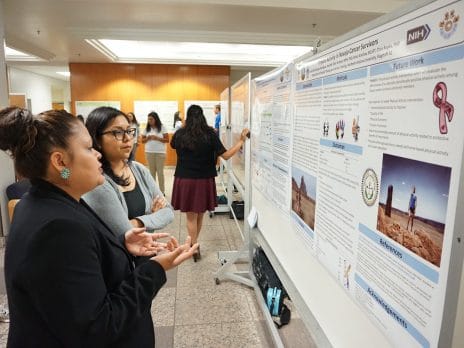Restoring Balance: Physical Activity and Cancer Among Native American Cancer Survivors
Project Co-leaders
Dirk De Heer, PH.D., (NAU) Anna Schwartz, PH.D., (NAU), Jennifer Bea, Ph.D., (UACC)
Program Coordinator/Research Specialist
Etta Yazzie, RN (UACC/NAU), Taylor Lane (NAU)
Student Researchers
Kaitlyn Haskie (NAU), Ravina Thurasingam (UA), Rachel Sleeman (NAU), Alaitia Enjady (NAU)
Former Students
Pearl Nez (NAU), Mark Lee (UA), Brian Kinslow (NAU), Stephanie Muther (NAU), Clyde Yellowhair (NAU), Ashlee Paige (UACC), Luis Valdez (UACC), Wyatt Betony (Dine College, NAU Bridges), Jenille Montelongo-Rodriguez (Coconino CC, NAU Bridges)
Background
Studies have shown that physical activity in cancer survivorship can lead to improved quality of life and disease-free survival, particularly for colorectal and breast cancer patients. Relatively moderate amounts of physical activity may be needed, such as walking 30 minutes daily at 2.5 miles per hour. None of these studies, however, were focused on Native American cancer survivors. In response, our team conducted a qualitative study to evaluate barriers and facilitators for activity among Native cancer survivors (phase 1). Based on this information, a tailored physical activity intervention was developed. The intervention included forming a partnership with local facilities which specialize in serving Native Americans to deliver the intervention. This insured that individuals working directly with survivors understand the cultural nuances around discussing cancer and treatment, common barriers, environmental circumstances and historical context of the population. Also, all activities and materials were closely reviewed to ensure alignment with traditional cultural preferences and feasibility in the environment. Finally, ensuring adequate flexibility of scheduling to accommodate geographically dispersed participants was also essential.
Objective
To implement and evaluate a physical activity intervention among Native American cancer survivors. A pilot study with Navajo cancer survivors was conducted in 2016-2017. This pilot study will be expanded to 4 sites across Northern Arizona from 2017-2019.
Methods
The Pilot Project included one urban site in Flagstaff and one rural site on the Navajo Nation. Each participant was randomized to immediate or delayed start of the physical activity intervention. The intervention itself consisted of a 12-week physical activity project including weekly one-on-one sessions with an exercise physiologist, as well as a detailed at-home exercise program. Participants were measured at baseline 6-weeks, 12-weeks and 18-weeks. Measurements included 1) surveys on quality of life and social isolation; 2) clinical measures including body composition, HbA1c, and blood pressure; and 3) functional measures including a 6-minute walk and 30-second sit-to-stand test. Participants were also provided with a Garmin Vivofit activity tracker to monitor activity continuously.
Findings
A total of 16 survivors and 5 family members have been enrolled in the study (6 breast, 4 colon/gastric, 2 uterine/ovarian, 2 multiple myeloma, 1 other cancer) were 55.5 ±10.4 old. Baseline measures indicate health status was below national averages, BMI 31.2kg/m2±4.3, Body Fat % 42.7±10.5, Waist Circumference 99.3cm±29.1, HbA1c 6.8±2.0, six-minute walk 0.21Miles±0.1. Social isolation, however, was low, 1.82±0.81 on 1 (Never) -5 (Always) scale and the PROMIS score showed moderate quality of life 3.0±0.88 from 1 (Poorly)- 5 (Excellent). Final follow-up data is currently being collected and analyzed.
Conclusion
This is the first physical activity intervention specifically aimed at Native American cancer survivors. The project will expand to 4 sites from 2017-2019, and include 2 sites on the Navajo Nation and 2 urban sites. Baseline data suggests that exercise programs present important opportunities for enhancement of physical function and health for Native American cancer survivors, and social connectedness may be an important strength to draw upon.
